The physical therapy supplies market is experiencing steady expansion, driven by increased demand for rehabilitation care, rising sports injuries, and an aging population with mobility challenges. Healthcare system reports and hospital procurement data have highlighted sustained investments in physiotherapy departments, particularly in outpatient and home-based care settings.
Technological enhancements in treatment modalities, such as portable and high-frequency ultrasound therapy devices, have further supported clinical adoption across a wide range of specialties. Additionally, awareness campaigns promoting early musculoskeletal care and injury prevention have improved access to physiotherapy services for non-geriatric populations.
Insurance coverage for physical therapy sessions and supportive health policies in both developed and developing regions have contributed to increased utilization of physical therapy supplies. Looking forward, the market is expected to witness consistent growth, supported by advancements in ergonomic therapy tools, digital physiotherapy platforms, and the expansion of musculoskeletal care programs. Segmental leadership is anticipated to continue across ultrasound devices, non-geriatric demographics, and musculoskeletal applications due to their broad therapeutic scope, preventive care focus, and integration in routine rehabilitation protocols.
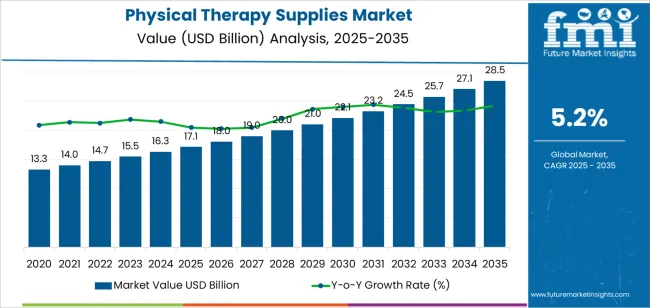
| Metric | Value |
|---|---|
| Physical Therapy Supplies Market Estimated Value in (2025 E) | USD 17.1 billion |
| Physical Therapy Supplies Market Forecast Value in (2035 F) | USD 28.5 billion |
| Forecast CAGR (2025 to 2035) | 5.2% |
The market is segmented by Type, Demographics, Application, and End Use and region. By Type, the market is divided into Ultrasound, Hydrotherapy, Cryotherapy, Continuous Passive Motion, Electric Stimulation, Heat Therapy, Therapeutic Exercise, and Others. In terms of Demographics, the market is classified into Non‑Geriatric Population and Geriatric Population. Based on Application, the market is segmented into Musculoskeletal, Neurology, Pediatrics, Cardiovascular & Pulmonary, and Other Applications. By End Use, the market is divided into Hospitals & Clinics, Rehabilitation Centers, and Others. Regionally, the market is classified into North America, Latin America, Western Europe, Eastern Europe, Balkan & Baltic Countries, Russia & Belarus, Central Asia, East Asia, South Asia & Pacific, and the Middle East & Africa.
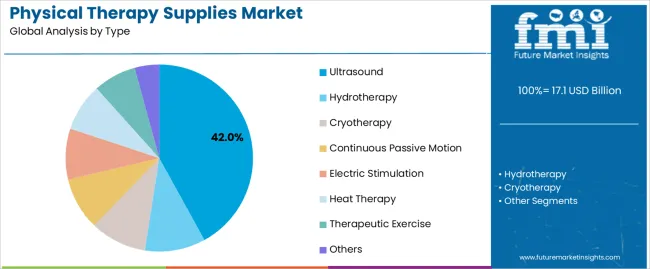
The Ultrasound segment is projected to account for 42.0% of the physical therapy supplies market revenue in 2025, maintaining its dominance due to its effectiveness in deep tissue stimulation and accelerated healing. Growth in this segment has been driven by increased clinical reliance on ultrasound therapy for treating soft tissue injuries, inflammation, and chronic pain.
Healthcare providers have favored ultrasound devices for their non-invasive nature, portability, and ability to enhance blood flow and cellular repair processes. Advancements in device miniaturization and user-friendly digital interfaces have facilitated widespread use in both clinical and home care environments.
Moreover, manufacturers have developed cost-effective models catering to physiotherapy clinics, sports centers, and rehabilitation facilities. As musculoskeletal disorders and sports-related injuries become more common across all age groups, the demand for therapeutic ultrasound is expected to remain strong, sustaining the segment’s market leadership.
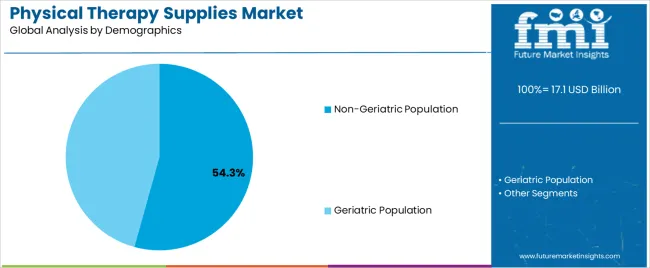
The Non-Geriatric Population segment is projected to contribute 54.3% of the physical therapy supplies market revenue in 2025, leading the demographic segmentation. Growth in this segment has been supported by rising physical activity levels, increasing participation in sports and fitness routines, and a surge in workplace-related musculoskeletal conditions.
Younger adults have increasingly sought early intervention for pain management and injury prevention, leading to greater utilization of physical therapy services. Corporate wellness programs and preventive care initiatives have also played a role in encouraging therapy engagement among working-age individuals.
Additionally, non-geriatric populations have demonstrated higher adoption of digital physical therapy tools, including app-based exercise tracking and portable therapy devices. The segment's prominence reflects the broader trend of proactive health management and the growing recognition of physical therapy’s role in long-term musculoskeletal wellness.
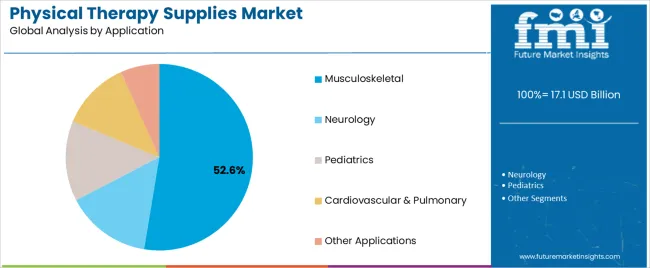
The Musculoskeletal segment is projected to represent 52.6% of the physical therapy supplies market revenue in 2025, establishing itself as the largest application area. This growth has been driven by the high prevalence of conditions such as back pain, arthritis, ligament injuries, and post-surgical rehabilitation needs.
Clinical guidelines and orthopedic care protocols have increasingly incorporated physical therapy as a first-line or adjunct treatment for musculoskeletal disorders. Healthcare providers have emphasized early mobilization and targeted exercises to improve patient outcomes and reduce surgical intervention risks.
The rise in sedentary lifestyles and ergonomic stress among the global working population has further increased the incidence of musculoskeletal complaints. Innovations in therapy equipment specifically designed for joint mobilization, muscle strengthening, and postural correction have also expanded treatment capabilities. With musculoskeletal conditions continuing to be a leading cause of disability worldwide, this segment is expected to retain its dominant role in the market.
Based on several semi-annual periods from 2025 through 2035, the following table illustrates the anticipated CAGR for physical therapy supplies. A CAGR of 5.2% is predicted for the first half (H1) of the decade from 2025 to 2035, followed by an attenuated 4.9% growth rate in the second half (H2).
| Particular | Value CAGR |
|---|---|
| H1 | 5.2% (2025 to 2035) |
| H2 | 5% (2025 to 2035) |
| H1 | 4.9% (2025 to 2035) |
| H2 | 4.6% (2025 to 2035) |
Moving forward into the next period, from H1 2025 to H2 2035, the annual CAGR is projected to reach 4.9% in the first half and remain relatively low at 4.6% in the second half.
Aging Population and Advanced Technologies to Drive Physical Therapy Supplies Market
Physical therapy supplies are driven by an aging population worldwide since older adults are more likely to have conditions related to mobility, arthritis, and osteoporosis.
A rising incidence of chronic diseases such as cardiovascular diseases, diabetes, and obesity is leading to an increase in long-term physical therapy demand. As physical therapy continues to be acknowledged and adopted as an effective method of recovery and rehabilitation, the industry is expected to grow further.
A number of technological advances are improving the efficiency and accessibility of physical therapy, such as augmented reality, robotic rehabilitation devices, and telehealth solutions. Numerous government funding programs and reimbursement policies contribute to the accessibility and affordability of physical therapy.
A combination of these factors creates a robust industry environment for manufacturers and suppliers supplying physical therapy supplies. As a result, the demand for physical therapy supplies is on the rise.
Wearable Technologies and Home Care Services Contribute to a Growing Trend
The use of online and remote physical therapy services has increased significantly in recent years. With the COVID-19 pandemic in full swing, therapy services have become more convenient and accessible for clients.
With the introduction of wearable technology, patients can track and monitor their progress in real-time, allowing personalized therapy and improved outcomes.
The use of artificial intelligence and machine learning in physical therapy practices is allowing practitioners to create personalized treatment plans and predict outcomes. In addition to preventive care, physical therapy is proving to be increasingly popular with patients in order to prevent serious health problems from occurring in the future.
In recent years, overall health and fitness have become increasingly important. The industry for patients wishing to receive physical therapy at home has also grown as portable and easy-to-use home-based physical therapy equipment has become available.
Physical Therapy Supplies will Benefit from Digital Health Technologies
Developing and offering a wide assortment of physical therapy supplies, including advanced therapeutic devices, exercise equipment, and components, will increase sales. To enhance the adoption and loyalty of physical therapy products, educational initiatives and training programs are being introduced to keep physical therapists informed about the latest techniques and products.
Increased customer satisfaction and recurring business can be achieved by providing better service, extensive support, and user-friendly products.
New markets have seen a rise in physical therapy as healthcare infrastructure has improved, providing significant opportunities to industry players. Investment in research and development can lead to higher industry shares with innovative products such as smart rehabilitation devices, advanced exercise equipment, and user-friendly home therapy programs.
Using digital health technologies can help patients engage in therapy and adhere to treatment regimens, from tracking therapy with mobile apps to immersive therapy sessions using virtual reality.
The development of personalized therapy solutions based on data analytics and feedback from patients can result in improved therapy outcomes and improved patient satisfaction, resulting in increased brand loyalty.
Regulatory Uncertainty Regarding Physical Therapy Supplies May Restrict Industry Growth
Small clinics and individuals seeking to use physical therapy goods at home may find purchasing physical therapy goods to be a costly endeavor.
The development and promotion of new products and machinery may be affected by several rules and regulations in the physical therapy field. The process of overcoming these regulatory barriers can be time-consuming and expensive for producers.
Modifications to healthcare insurance policies and coverage significantly impact the cost of care incurred by patients. The result could be a reduction in quality and a variation in services. The cost of healthcare can restrict patient's access to healthcare services, resulting in situations where they cannot receive necessary treatment.
Insurance policies and government programs may restrict clinics from investing in the latest technologies. Physical therapy clinics might have difficulty comparing products and making wise purchases when industry standards do not exist. The lack of consistency could adversely affect patient safety and outcomes.
The physical therapy supplies market registered a CAGR of 4.9% during the historical period between 2020 and 2025. A value of USD 17.1 billion was achieved in 2025 for the physical therapy supplies market, up from USD 13.3 billion in 2020.
Positive growth was observed in the physical therapy supplies market as cost-saving and remote service initiatives gained traction. In addition to improving rehabilitation outcomes, multidisciplinary approaches have been found to be effective.
Some physical therapy practices let their patients download apps for their phones. It is possible for patients using these apps to contact their physical therapy doctors, view their own statistics, and even follow instructions on how to carry out guided exercises through the use of these apps.
A few decades have passed since myofascial release treatment was introduced, but the tools that are used are always changing. By using these tools, therapists are able to provide more effective treatments for myofascial release.
The World Health Organization estimates that one out of three people in the world suffers from chronic pain. Having pain is one of the leading causes of lost productivity, which in turn has a significant impact on the economy. Diabetes, hypertension, cancer, and arthritis are common chronic diseases associated with acute pain.
Physical therapy procedures are made easier and more efficient when robotic devices are utilized in robot-assisted therapy.
In addition to helping with repetitive workouts, these tools can also give patients and therapists real-time feedback about their progress as well as enable precise and controlled movements during the workout. Several illnesses have shown promising outcomes with robot-assisted therapy, including spinal cord injury and stroke recovery.
Tier 1 companies represent industry leaders, capturing a sizeable industry share of 27% in the global industry. These are companies that provide direct service to consumers, businesses, or original equipment manufacturers (OEMs).
Companies in the physical therapy supplies market tend to be larger, well-established corporations whose products are distributed directly to patients, clinics, and hospitals. Businesses with strong brands, good distribution networks, and the ability to launch new products quickly are the best.
Since they have direct industry access and can react quickly to changes in demand, they tend to do well. Prominent companies within Tier 1 include BLT, Performance Health, Zimmer MedizinSysteme GmbH, and Storz Medical AG.
Mid-size players in Tier 2, with a 33% market share, have a strong presence in specific regions and influence local markets. Their strengths include a strong overseas presence and a detailed understanding of their markets. Parts and components are supplied to Tier 1 companies by Tier 2 companies.
Companies involved in such production may manufacture components or materials used in the production of physical therapy equipment. Despite not directly dealing with end customers, these businesses make up an integral part of the supply chain. Tier 2 companies include Dynatronics Corporation, RICHMAR, EMS Physio Ltd., and Enraf-Nonius.
Tier 3 consists mostly of small businesses with a local presence that serves niche markets. Companies in Tier 3 typically supply basic components or raw materials to Tier 2 companies. Industry fluctuations can significantly impact the performance of these firms since they often are farther from the final product.
The success of their operations is often inextricably linked to the health of the industry as well as their ability to provide the necessary materials for the broader supply chain. Low margins and high volumes determine their performance, making them more vulnerable to raw material price fluctuations. Players include ITO Co. Ltd, and Whitehall Manufacturing.
Detailed industry analysis of physical therapy supplies markets are provided for different countries. An analysis of industry demand is provided for several regions around the world, including North America, Europe, Asia Pacific, and others.
The United States is anticipated to remain at the forefront in North America, with a value share of 77.6% through 2035. In Asia Pacific, South Korea is projected to witness a CAGR of 4.7% by 2035.
| Countries | Value CAGR (2025 to 2035) |
|---|---|
| United States | 5% |
| Canada | 3.9% |
| United Kingdom | 5.1% |
| Germany | 5.4% |
| India | 6.1% |
| China | 5.8% |
| Thailand | 5.5% |
Physical therapy in the United States is expected to experience a significant increase in demand in the future. Numerous factors have contributed to the demand for these services, including the aging population and the desire to remain active in retirement. Physical therapy is vital for older people suffering from heart attacks, strokes, and impaired mobility that require rehabilitation.
Favorable reimbursement policies and insurance coverage are fueling business growth. Since the Affordable Care Act and other healthcare reforms have improved rehabilitation services' coverage, a greater number of people are able to access physical therapy. This increases the demand for physical therapy supplies as physical therapy services become more prevalent.
The United Kingdom industry is expected to show significant growth over the next few years. Over the forecast period, the industry is projected to expand at a CAGR of 5.1%. The rising prevalence of musculoskeletal disorders in the United Kingdom is driving demand for physical therapy supplies.
A growing focus on various forms of research and development and government funding to increase growth. In addition, physical therapy is becoming more widely recognized as a treatment option, thereby increasing industry growth.
Increased participation in physical activities is driving interest in fitness and sports in the United Kingdom. The increased number of sports-related injuries calls for the development of more tools and services in the field of physical therapy. Sedentary lifestyles and government initiatives promoting exercise are also contributing to this trend.
A positive growth trajectory is being shown in the industry for physical therapy supplies in India. The industry in India is likely to expand at a CAGR of 6.1% from 2025 to 2035.
Private healthcare facilities and specialist clinics are increasing, driving demand for physical therapy services. In addition to improving accessibility and affordability of healthcare, government initiatives also aid the industry's growth. The availability of affordable healthcare services will further boost the industry's demand.
A rise in medical tourism and the expansion of rehabilitation centers will enhance the country's economic growth. Healthcare centers will increase initiatives and introduce therapy programs in the coming years, which will lead to an expansion of the industry.
As awareness of aquatic therapies grows and adoption increases, the industry will flourish. The availability of different insurance plans and the demand for effective treatments have led to consumers adopting therapies remotely from their houses.
Information about the industry's leading segments is provided in this section. The ultrasound segment accounted for 42% of the value share in 2025. Based on the application, musculoskeletal had a market share of 63.4% in 2025.
| Type | Ultrasound |
|---|---|
| Value Share (2025) | 42% |
The ultrasound segment held the largest industry share in terms of revenue, accounting for approximately 42% of the industry in 2025. Musculoskeletal issues can be successfully treated using ultrasound therapy, which reduces pain and promotes tissue healing. The popularity of it has led to a spike in demand for physical therapy supplies and equipment.
Professionals and physiotherapists utilize a therapeutic ultrasound device to treat pain issues and promote tissue healing. Ultrasound therapy uses sound waves that are outside the range of human hearing in order to treat ailments such as runner's knee and muscle strains. The benefits of ultrasound therapy are becoming more apparent to both patients and medical professionals.
Physical therapists are receiving more training in ultrasound procedures each year, resulting in an increase in adoption rates, which in turn leads to a rise in the demand for ultrasound supplies.
The advancement of ultrasound technology, including portable and handheld devices, has streamlined the integration of ultrasound therapy into physical therapy procedures and opened up new avenues for ultrasound therapy. As a result of these developments, clinics are now using ultrasonography more frequently, thereby increasing the demand for items related to ultrasonography.
| Application | Musculoskeletal |
|---|---|
| Value Share (2025) | 63.4% |
The musculoskeletal segment generated 63.4% of revenue in 2025. Musculoskeletal physiotherapy is one aspect of physical therapy that focuses on identifying, managing, and preventing musculoskeletal disorders.
Various alignments, such as tendons, muscle strains, and joint pain, are addressed. A major objective of musculoskeletal physiotherapy is to increase mobility, strength, and flexibility while alleviating pain and inflammation.
Musculoskeletal physiotherapy is one of the most crucial aspects of many healing therapies. Musculoskeletal care includes identifying, managing, and avoiding conditions that can affect the body.
A wide range of supplies and equipment are utilized in musculoskeletal physical therapy, including electrical muscle stimulation equipment, orthopedic immobilization devices, rehabilitation equipment, and isokinetic devices. By using these tools, therapists can provide efficient and thorough treatment for patients with musculoskeletal conditions.’
Patients with musculoskeletal conditions may also benefit from exercise programs recommended by physical therapists. A physical therapist may also employ manual therapy techniques such as manipulations, mobilizations, and massages along with exercises to relieve pain and increase mobility.
Physiotherapists can use exercises and stretches as part of the process of improving mobility, strength, and flexibility. Patients can benefit from these exercises when combined with other treatments to meet their specific needs.
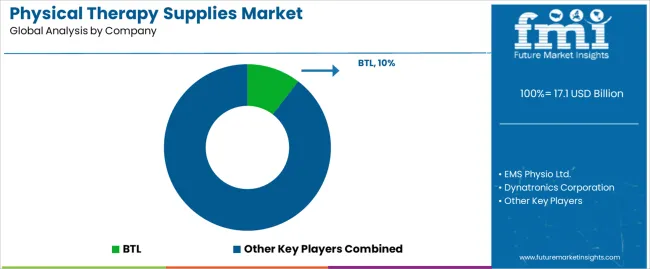
Manufacturers are adopting a variety of marketing strategies to reach potential buyers and expand their customer base, including launching new products, expanding globally, and partnering.
Recent Industry Developments in Physical Therapy Supplies Market
In terms of type, the industry is divided into hydrotherapy, cryotherapy, continuous passive motion, ultrasound, electric stimulation, heat therapy, therapeutic exercise, and others.
In terms of capacity, the industry is segregated into a non-geriatric population and, a geriatric population.
In terms of application, the industry is segmented into neurology (stroke, spinal cord injuries, Parkinson’s disease, multiple sclerosis, cerebral palsy, and others), musculoskeletal, pediatrics, cardiovascular & pulmonary, and others.
The industry is classified by end-use industries as hospitals & clinics, rehabilitation centers, and others.
Key countries of North America, Latin America, Western Europe, Eastern Europe, South Asia, East Asia, Middle East and Africa have been covered in the report.
The global physical therapy supplies market is estimated to be valued at USD 17.1 billion in 2025.
The market size for the physical therapy supplies market is projected to reach USD 28.5 billion by 2035.
The physical therapy supplies market is expected to grow at a 5.2% CAGR between 2025 and 2035.
The key product types in physical therapy supplies market are ultrasound, hydrotherapy, cryotherapy, continuous passive motion, electric stimulation, heat therapy, therapeutic exercise and others.
In terms of demographics, non‑geriatric population segment to command 54.3% share in the physical therapy supplies market in 2025.






Full Research Suite comprises of:
Market outlook & trends analysis
Interviews & case studies
Strategic recommendations
Vendor profiles & capabilities analysis
5-year forecasts
8 regions and 60+ country-level data splits
Market segment data splits
12 months of continuous data updates
DELIVERED AS:
PDF EXCEL ONLINE
Physical-Digital Integration Market Size and Share Forecast Outlook 2025 to 2035
Physical Security Information Management (PSIM) Market Size and Share Forecast Outlook 2025 to 2035
Physical Security Market Insights - Growth & Forecast through 2034
Physical Security Equipment Market Analysis – Growth & Trends 2017-2027
Cyber-Physical System Market Size and Share Forecast Outlook 2025 to 2035
Paraffin Physical Therapy Market Size and Share Forecast Outlook 2025 to 2035
IV Therapy and Vein Access Devices Market Insights – Trends & Forecast 2024-2034
Mesotherapy Market Size and Share Forecast Outlook 2025 to 2035
Cryotherapy Market Growth - Demand, Trends & Emerging Applications 2025 to 2035
Aromatherapy Market Size and Share Forecast Outlook 2025 to 2035
Radiotherapy Positioning Devices Market Size and Share Forecast Outlook 2025 to 2035
Cell Therapy Systems Market Size and Share Forecast Outlook 2025 to 2035
Chemotherapy-Induced Nausea And Vomiting Therapeutics Market Size and Share Forecast Outlook 2025 to 2035
Phototherapy Lamps And Units For Aesthetic Medicine Market Size and Share Forecast Outlook 2025 to 2035
Phototherapy Equipment Market Size and Share Forecast Outlook 2025 to 2035
Phototherapy Treatment Market Size and Share Forecast Outlook 2025 to 2035
Heat Therapy Units Market Analysis - Size, Share, and Forecast 2025 to 2035
Chemotherapy Induced Anemia Market Trends and Forecast 2025 to 2035
Radiotherapy Patient Positioning Accessories Market Trends – Forecast 2025 to 2035
Phototherapy Lamps Market Growth - Trends & Forecast 2025 to 2035

Thank you!
You will receive an email from our Business Development Manager. Please be sure to check your SPAM/JUNK folder too.
Chat With
MaRIA